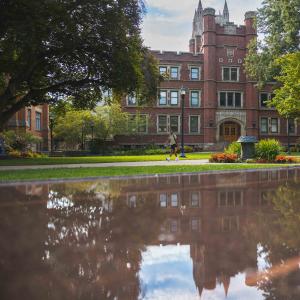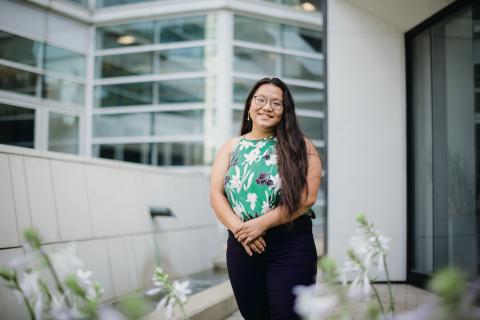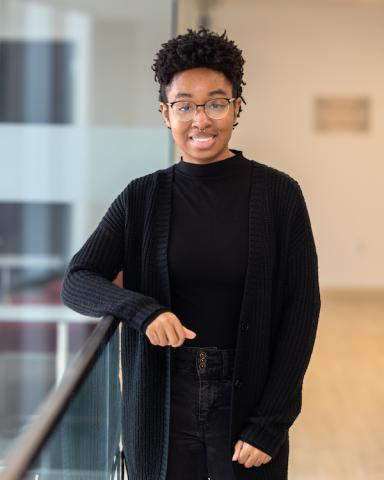Individual donors, foundations and corporate partners provide paths to CWRU for Cleveland students
In 2003, Cleveland’s future was in crisis.
At 31.3%, the overall poverty rate was more than twice the national average, with nearly half of the city’s children qualifying as impoverished. Yet even as the Cleveland Metropolitan School District (CMSD) reported a 40% high school graduation rate, hundreds of teachers and city school staff were laid off due to budget cuts. The following year, Cleveland was declared the poorest big city in the U.S.
Case Western Reserve University faculty member Nathan Berger, MD, wanted to be part of the solution—starting with the education of the next generation.
“There were obviously still very bright students all around, but they weren’t getting the kind of education or opportunities they needed to succeed,” said Berger, the Hanna-Payne Professor of Experimental Medicine and director of the Center for Science, Health and Society at the School of Medicine. “I knew if we could get them in the lab to do hands-on research, they would fall in love with the excitement of discovery and consider careers in research and healthcare.”
He began designing the Scientific Enrichment and Opportunity (SEO) program, which would bring CMSD high schoolers to campus for eight weeks of biomedical research under the guidance of School of Medicine faculty mentors. Because many students work full time over the summer to help support their families, the program would also need to offer a stipend to make the time commitment feasible.
A local family foundation made an initial investment to launch SEO, followed by grants from both regional and national foundations, and gifts from individual donors.
Of the 456 total students who have participated in the immersive research experience since it launched in 2004, 93% graduated high school and 88% attended college. Those numbers have jumped to 100% and 97% respectively since a 2018 grant from the National Cancer Institute established a partner program, Youth Enjoy Science (YES). In the past five years, 21 alumni of SEO and YES have enrolled at Case Western Reserve.
“It’s important for the individual students to have these pathways to success, but it’s also important for the wellbeing of the entire community,” said Berger, who was honored with the School of Medicine’s Lifetime Achievement Award in 2022 for 40 years of service.
Thanks to a multi-pronged approach by CMSD and the City of Cleveland, the district has seen immense progress the past two decades, reporting an overall 80.1% graduation rate in 2021. But while the nation’s poverty rates have declined since 2003, Cleveland’s remains largely unchanged at 31.4%. With more students graduating high school, the need for college scholarships and wraparound services is higher than ever.
Opening doors
Lily Kwiatkowski’s educational journey with CWRU began when she was accepted to the Scientific Enrichment and Opportunity program the summer before her junior year of high school.
“Being in that lab was one of the best experiences I’ve had in my life,” said Kwiatkowski. “This program got me on a path that changed my life in ways I could never have imagined.”
In addition to developing critical research skills, SEO enabled Kwiatkowski to grow a professional network that quickly produced even more opportunities, including the chance to shadow physicians and have her name included on two published papers—a rare accomplishment for a high schooler.
The experience solidified Kwiatkowski’s desire to enter medicine and tackle systemic disparities, but cost would be a significant obstacle. So she applied for—and received—the highly competitive Joan C. Edwards Scholarship.
Awarded annually to one outstanding CMSD graduate, the eight-year scholarship covers full tuition and living expenses for recipients to pursue undergraduate degrees at Case Western Reserve and, if successful, continue to receive such support at the university’s medical school.
It was created by the Joan C. Edwards Charitable Foundation for its late namesake—a jazz singer whose philanthropy focused on advancing medicine and the arts. The directions in her estate were plain: “Provide medical education to communities in need of physicians.”
And while Cleveland is renowned for healthcare, the vast majority of its providers do not reflect the populations they serve—a problem faced nationwide.
In the early 2000s, CWRU School of Medicine leadership wanted to address this issue by building a pipeline from CMSD, but, according to a professor on faculty at the time, had not enrolled a student of color from the predominantly Black district in nearly a decade.
“Bridges come before pipelines,” said Robert L. Haynie (GRS ’72, chemistry; MED ’78), clinical associate professor emeritus of medicine. “Pipelines only go in one direction, but bridges go two ways. We had to connect with our community first.”
Haynie established the Robbins Bridge Program in 2008, working with students of the nearby CMSD magnet school, Cleveland School of Science and Medicine, to spark interest in medical practice, research—and Case Western Reserve.
The program caught the attention of Brian McDonald, executive director of the Joan C. Edwards Foundation. A 2009 grant from the foundation built upon the idea, broadening Robbins Bridge’s tutoring and college preparation offerings and establishing the Edwards Scholars Program.
“CWRU School of Medicine is uniquely positioned to make a significant difference in the Cleveland community,” said McDonald (MGT ‘16), “and this is exactly the sort of partnership Joan envisioned for her foundation. We are grateful to play a role in expanding access to a quality education for our future doctors, researchers and leaders.”
Beyond reducing the financial burden, programs such as the Joan C. Edwards Scholarship can alter the course of a student’s career.
“I wouldn’t have been able to afford even one year at CWRU,” said Kwiatkowski (CWR ‘23), who completed classes for her bachelor's degree in chemical biology last fall—a semester ahead of schedule. “It’s a huge burden lifted.”
As Robbins Bridge initiatives gained momentum, McDonald and Case Western Reserve leadership identified another hurdle: getting students to graduation.
A solution emerges
In 2010, soon after the collaboration between the foundation and university began, an American Community Survey estimated that 15.6% of people aged 25 and older in the area surrounding CWRU had a bachelor’s degree or higher. This meant that many graduates of the Cleveland Metropolitan School District were first-generation college students and lacked preparation for navigating higher education—challenges that remain true today.
One solution? The Emerging Scholars Program (ESP)—a strategic assembly of resources designed to ensure Case Western Reserve students from Cleveland-area high schools reach graduation. The university’s College of Arts and Sciences launched ESP in 2011 with support from the Joan C. Edwards Charitable Foundation, among others.
A summer bridge program before the first semester of undergraduate study eases the transition to campus life, and relationships with faculty and staff advisors guide scholars throughout their time at CWRU.
“Having mentors from these programs who provided both emotional and academic support made a huge difference,” said Kwiatkowski, who begins at CWRU School of Medicine in July. “It’s an incredible resource and an immense privilege.”
Pam Mascio is among the Emerging Scholars Program’s most passionate supporters. The Northeast Ohio native became involved with the university in 2014 with a gift for cancer research. She soon saw the variety of ways Case Western Reserve was creating opportunities for low-income students and recognized a chance to make a tangible impact in her community.
“When I heard about Emerging Scholars, I was really impressed by the holistic approach,” said Mascio, whose philanthropy at the university includes an undergraduate scholarship fund established in 2021. “College is intimidating for anyone, so I can only imagine how challenging it must be for someone who is the first in their family to attend. To truly address the unique barriers many of these students face lays a strong foundation for success.”
The proof is in the outcomes: Participants in the Emerging Scholars Program graduate from CWRU at higher rates than their non-ESP peers and often pursue advanced degrees.
“Emerging Scholars is a wonderful example of how scholarships and support services can help ensure students have the resources they need to receive their diplomas,” said Joy K. Ward, dean of the College of Arts and Sciences and Case Western Reserve’s interim provost. “We are grateful to donors at every level for investing in our students as the future leaders and innovators who will make a true difference in our world."
A dream realized
LaNyah Terry hopes to be one of those future innovators. Inspired by personal experiences with chronic illness, Terry is considering a research career in pharmaceutical science to develop new treatments for physical and mental ailments.
Terry first came to Case Western Reserve University in the sixth grade with nearly 200 other girls from CMSD schools as part of a General Electric-sponsored program designed to ignite interest in science, technology, engineering, math and medicine. Though her memories of the activities are fuzzy, she remembers clearly the lively buzz of students running to and from class, and knew she one day wanted to join them.
“Case Western Reserve was my first choice for college,” she said, “but I wasn’t sure if I would get in.”
Terry’s father died while she was in middle school, which affected her grades. It also made money tight at home. Even if she was accepted to CWRU, Terry recalled, she wasn’t sure if her family could afford it. Her mother encouraged her to attend Case Western Reserve despite the financial challenges, and she arrived on campus as a first-year student in August 2022.
During Terry’s first semester, she and her mother got a surprise: She received The Alumni Association of Case Western Reserve University’s Endowed Scholarship—a partial scholarship fueled by the support of nearly 450 alumni and friends.
The Alumni Association’s Board of Directors began raising money for a term scholarship in 2016 and, motivated by early successes, soon increased their goal. The fund was endowed at $60,250 in 2021 and is valued at more than $121,000.
Though it does not cover her full tuition, the scholarship reduces strain on Terry’s family.
“Now we know we can cover tuition next semester and I can focus on school instead of the financial stress," said Terry, a chemistry major who's active in research as well as student organizations such as the American Sign Language Club, the African American Society and the Sisterhood. “I hope the program continues for other students because it has made such a big difference for me.”
Originally published in the summer 2023 issue of Forward Thinking magazine




